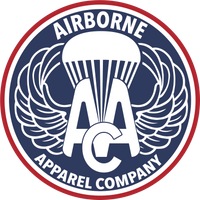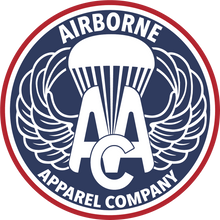We love those Aircraft ID cards (GTA 44-2-1) we used to study back in the day. The black silhouettes are stamped in our brains, whether we remember the aircraft they represent or not. Since there aren't any card sets that cover all the US Air Corps and Air Force planes that have served the Airborne so well, we decided to make our own!
These products were all created in house - not copied from existing cards (we even made a custom font for these) to bring a bit of nostalgia and yes, even some educational facts, to your shelf, cupboard, wall or closet.
So while the GTA 44-2-1 Visual Aircraft Recognition cards may be limited in their recognition of the list of "perfectly good" airplanes we've jumped from, Airborne Apparel Co. found a way to bring them to life.
ABOUT THE AIRCRAFT
Douglas C-47 Skytrain
The C-47 Skytrain is the aircraft that carried the Airborne into history. A militarized version of the DC-3, the C-47 delivered paratroopers into Normandy, Sicily, Holland, and countless other battlefields during World War II. Its twin radial engines, rugged construction, and ability to operate from rough or improvised airstrips made it the ideal troop carrier of its era. The C-47 could haul paratroopers, gliders, cargo, or medevac litters, earning its reputation as the workhorse of the Allied airborne forces.
Today, the silhouette of the C-47—complete with invasion stripes and jump doors—remains one of the most iconic images of WWII airborne operations. It represents the courage of those who stepped out into the night from its open doors and the heritage carried on by airborne units ever since.
Boeing C-17 Globemaster III
The C-17 Globemaster III is the modern backbone of strategic and tactical airlift. Entering service in the 1990s, the C-17 combines the global reach of a heavy jet with the short-field performance needed for austere, dirt-strip landings. Its four turbofans, swept wings, and massive rear loading ramp allow it to move paratroopers, vehicles, and outsized cargo to any corner of the world.
For airborne forces, the C-17 is the premier platform for mass tactical jumps and rapid-response missions. Whether delivering relief supplies or deploying an entire brigade, the C-17 represents speed, power, and global mobility unmatched by any aircraft in its class.
Lockheed C-141B Starlifter
The C-141B Starlifter defined long-range airlift from the Vietnam era through the early 2000s. With its stretched fuselage, high swept wings, and four jet engines, the C-141B offered the speed and range needed to move troops and cargo across continents. It performed countless aeromedical evacuations, humanitarian missions, and strategic deployments during its decades of service.
Airborne units trained regularly from the Starlifter, making it a key jump platform during the Cold War. Its distinctive profile and unmatched reliability cemented the C-141B as one of the most important transport aircraft in U.S. Air Force history.
Fairchild C-119 Flying Boxcar
The C-119 Flying Boxcar was a distinctive twin-boom cargo aircraft built specifically for troop and equipment delivery after WWII. Its large, box-shaped fuselage and rear clamshell doors made it ideal for dropping paratroopers, heavy equipment, and cargo platforms. From the Korean War into the Vietnam era, the C-119 was a primary airborne delivery aircraft.
With its unmistakable twin-tail silhouette and rugged utility, the C-119 played a crucial role in early Cold War airborne operations. It carried units into combat, supported special missions, and helped transition airborne forces into the jet age.
Lockheed C-5 Galaxy
The C-5 Galaxy is one of the largest military aircraft ever built, capable of carrying tanks, helicopters, entire units, and hundreds of paratroopers across the globe. Its massive wings, towering T-tail, and unique nose-hinge cargo door give it unmatched loading flexibility. Since entering service in the early 1970s, the C-5 has supported nearly every major U.S. military operation.
For airborne forces, the C-5 enables large-scale strategic insertion of troops and equipment. Its sheer size and capability make it a symbol of American logistics power and a cornerstone of global rapid-deployment strategy.
Waco CG-4A Glider
The Waco CG-4A glider silently delivered troops and equipment deep behind enemy lines during WWII. Built from steel tubing, wood, and fabric, it could carry 13 fully equipped paratroopers or equivalent cargo. Towed into battle by aircraft like the C-47, it was released near the objective and descended quietly for a surprise landing—playing major roles in Normandy, Market Garden, and Operation Varsity.
Its simple construction belied its importance. The CG-4A’s ability to land in tight, improvised fields made it invaluable to airborne operations, and it remains a symbol of innovation, bravery, and America’s glider infantry legacy.
Lockheed C-130 Hercules
The C-130 Hercules is the gold standard of tactical airlift and airborne operations. Since the 1950s, it has delivered paratroopers, cargo, and humanitarian aid to nearly every combat zone and disaster area on Earth. With its four turboprops, high wings, and rear ramp, the C-130 can operate from rough, short, or improvised airstrips—making it indispensable to rapid-response missions.
As one of the longest-serving and most versatile aircraft in Air Force history, the Hercules remains the iconic jump platform for American airborne forces. Durable, dependable, and endlessly adaptable, the C-130 continues to define the modern airborne experience.
Fairchild C-123 Provider
The C-123 Provider was built for rugged, short-field tactical operations, making it a natural fit for early Cold War airborne missions. Its high straight wings, twin radial engines, and rear loading ramp allowed it to deliver paratroopers and cargo into tight, unimproved landing zones. While its airborne role was relatively brief, the C-123 quickly proved itself in Southeast Asia, where its short takeoff and landing abilities excelled on rough jungle strips.
Over time, the Provider transitioned into specialized missions—including special operations and Agent Orange spray missions—yet it remains remembered for its early contributions to U.S. airborne and tactical airlift capability. Its chunky profile and versatile performance make it one of the more distinctive transport aircraft of its era.





